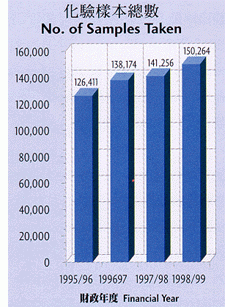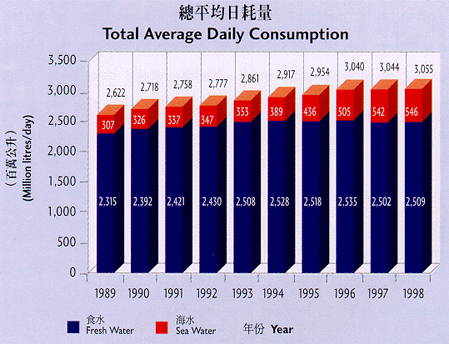Jump to the beginning of content
Director's Review and Looking Ahead
Towards the New Millennium
As we enter a new century we are aware that we will be facing new challenges. The first major challenge is understandably the need for computer compliance with the New Millennium. Indeed, the Year 2000 (Y2K) issue is one that confronts the whole world in varying degrees, and we have taken steps to deal with its possible effects on our water services. Final tests have been carried out during the year - and we have in hand contingency measures to cope with any unforeseen Y2K development.
While looking forward with a good deal of confidence and readiness to providing excellent water supply services to the public in the Year 2000 and beyond, we have either already carried out, or are also putting into place, a range of measures which will, among other things:
- ensure a continuing high quality of water to customers;
- offer improved services in customer relations and in our direct contact with people;
- where possible, introduce economies of scale and increased productivity - in keeping with the Enhanced Productivity Programme (EPP) being implemented by the Government;
- ensure an environmentally-friendly approach in every aspect of our activities, while at the same time making the public aware of our environmental policy and actions, and, very importantly
- where concerns and questions arise about the water supply services, or any other matter, to respond and deal with them in a timely manner.
Responding to Concerns
Since water so intimately affects the daily lives of the people, it is reasonable for them to expect a reliable supply of it - in sufficient quantities and of a consistently high quality.
During the year, questions were raised quite widely in the community about the quality of raw water from Dongjiang (East River), the discolouration of water emerging from customers' taps, and about the possible presence - or otherwise - of parasites in the treated water.
With regard to the Dongjiang raw water, various measures have been carried out by the Guangdong authorities to improve the quality of the water. Since the commissioning of the biological nitrification plant in Shenzhen Reservoir in January 1999, there has been marked improvement in water quality. Further improvement is expected when the construction of a closed aqueduct for conveying the water to Hong Kong is completed in 2002. Meetings are also regularly held between Water Supplies Department (WSD) staff and their Guangdong counterparts for discussions and monitoring of the measures taken.
In response to media publicity about the quality of drinking water within residential buildings, a study of this was carried out by consultants, particularly with regard to discoloured water. It confirmed our own findings that the problem was mainly caused by defects in the internal plumbing of the buildings, particularly the rusting of internal pipe work. Various steps have been taken in recent years to improve the water quality in buildings. An amendment to the Waterworks Regulations was enacted in December 1994 to discontinue the use of unlined galvanised steel pipe, which is prone to corrosion, for internal pipe work for buildings. To promote a better understanding of water quality control and maintenance responsibility of supply systems in buildings, a seminar on Water Supplies to Buildings was organised for property owners' incorporations and management companies in February 1999.
The long-term solution for existing buildings is to replace the internal plumbing system. This, combined with regular cleaning, will ensure a good quality of water for residents.
As a further measure of quality, the level of trichloromethane (THM) in the Hong Kong drinking water as a result of disinfection by chlorine has always been below the level of World Health Organisation (WHO) 1993 guidelines, as well as other international standards. With the expected continuing improvement in the quality of raw water, the level of THM will further decline.
With regard to concern expressed about the presence of Giardia and Cryptosporidium in the treated water -- as a result of reports of the presence of large numbers of such parasites in samples of tests undertaken in Sydney, Australia - our tests carried out over the past 18 months showed very little or no presence of the parasites.
Basically, the water treatment processes carried out by the WSD are able to effectively remove parasites through natural purification in reservoirs and by the processes of coagulation, sedimentation, filtration and chlorination. These will ensure that the potable water in Hong Kong complies chemically and bacteriologically with WHO guidelines for drinking water quality and is safe for consumption.
Extensive testing of samples and careful monitoring are carried out at various stages of the production process - prior to intake for treatment, during the process of treatment, at the time of delivery and at customers' taps. An average of 150 000 water samples are taken for tests each year.
Consumption Trend
There was a slight increase in total consumption of fresh water during the year, and a continuing rise in domestic use, partly offset by the steady decline in industrial use of water. Average daily fresh water consumption was 2.51 million cubic metres while sea water daily consumption was 0.55 million cubic metres.
Fresh water from pipes now reaches 99.8 per cent of the population, and efforts continue to bring it to the remaining 0.2 per cent of the people, living in the remotest areas.
Sea water, provided for flushing purposes, is supplied to 76 per cent of the population, showing an increase over the year before. Where feasible, this service will be extended to other areas.
Enhanced Productivity Programme (EPP)
Various measures are being taken to meet the Government's target for productivity enhancement of 5.5 per cent by 2002. These include employing contract staff, increasing automation and outsourcing, streamlining work procedures, deletion of vacant posts, and replacement of old plant and equipment. The savings in 1999/2000 will partly fund the new improvement plans, which include development and implementation of the ISO 9000 Quality Management System for such functions as design, construction, project management, as well as mechanical and electrical maintenance work. These activities will help improve the quality of service delivery.
Interaction with the Public
As a public service, we consider it a very important responsibility to reach out to the people, and to be both responsive, and readily accessible. To better understand customers' needs and growing expectations, a comprehensive opinion survey will be conducted shortly. At the same time, a mobile exhibition of various aspects of the WSD works and services will be brought to the people, calling on different venues, mainly in public housing estates, throughout the year.
Private Sector Participation
To further enhance the efficiency and cost-effectiveness of our operations, a consultant was appointed to conduct a study on having more private sector participation in the supply of water. The full implication of this, not the least being its impact on WSD staff, will be given the most careful consideration.
Staff have been advised of progress and there will be further extensive consultation and discussions on the way forward. Views arising from these will be forwarded to the Administration and will be taken into account in making the final decision.
Operating Expenditure
For the year, the total operating expenditure amounted to $4.93 billion, covering services in water supply, quality control and customer services. This compares with the $4.49 billion spent the year before, an increase of 9.7 per cent mainly due to a rise in staff costs and cost for purchase of Guangdong water.
Tariff Freeze
Meanwhile, the tariff freeze on charges enforced for the past four years was extended for a further period of six months from March 1999.
Staff Performance
On the whole, WSD staff perform with a high sense of dedication to their work. Indeed, the efficiency and productivity of staff may be gauged from their total achievement in meeting the demanding Performance Pledge targets and in some cases in exceeding them.
Regular monitoring is carried out to ensure continuing public satisfaction with our services, and the results are verified through customer opinion surveys conducted by independent organisations.
Nevertheless, the Department is alert to lapses of service efficiency that may occur and measures are rapidly taken to deal with them. During the year, certain steps were taken to improve the efficiency of the meter reading service.
Having taken over the responsibilities of my predecessor, Mr Hu Man-shiu, who is enjoying a well-deserved retirement, I am conscious, as he was, of our obligations to customers. I am also aware that the achievements of the Water Supplies Department can come only from the continuing commitment and dedication of all staff.
They have, for their part, chosen to demonstrate their devotion to public service in developing a set of values that are spelt out in the acronym 'CREDIT', for - customer satisfaction, reliability, environmental awareness, dedication, improvement and teamwork.
I commend them for that and we all look forward to working together in support of the community.
Hugh Phillipson
Director of Water Supplies
Director's Review and Looking Ahead


